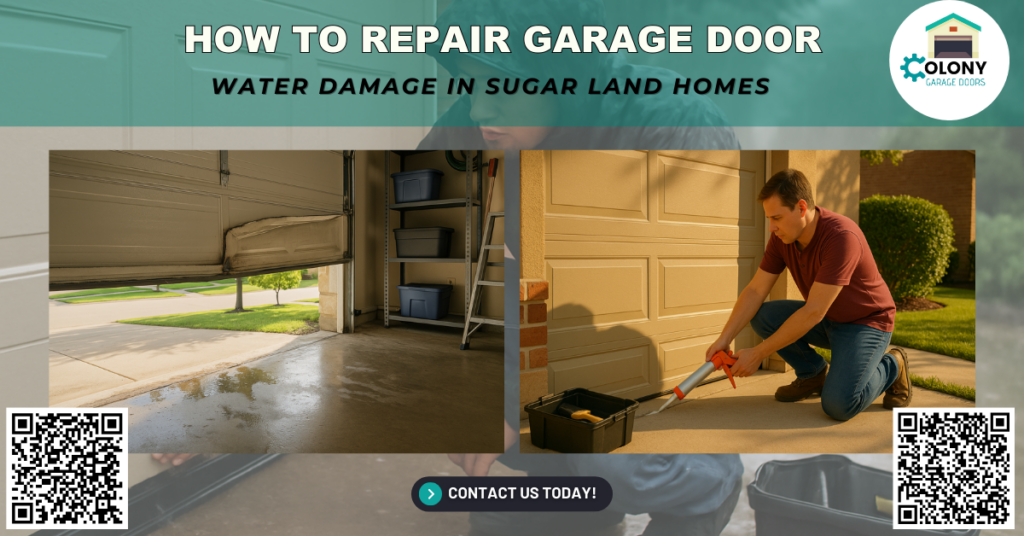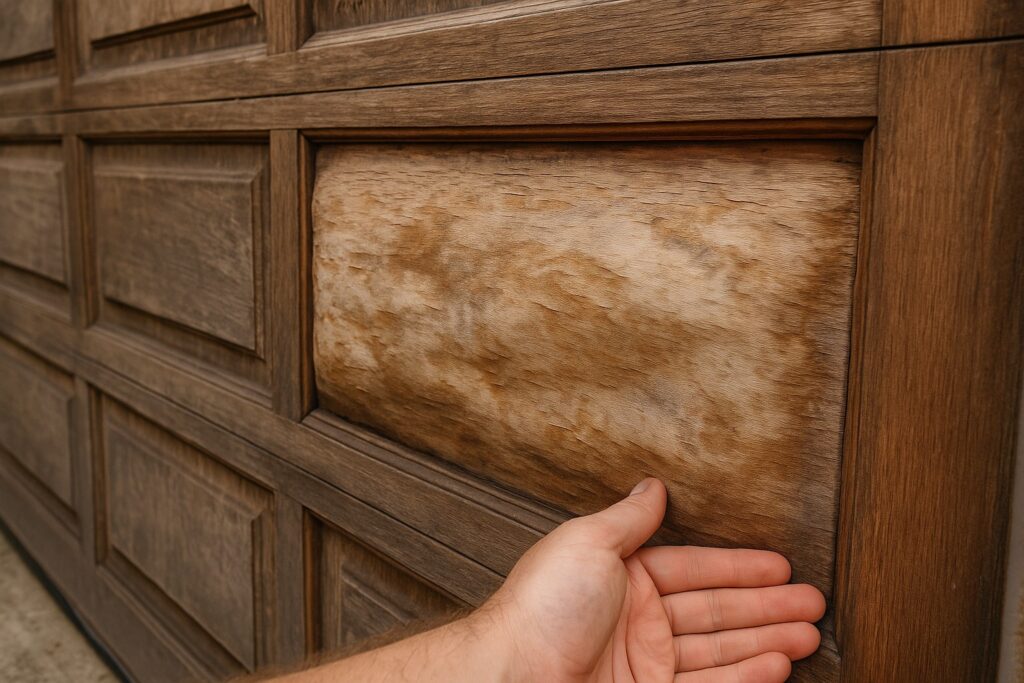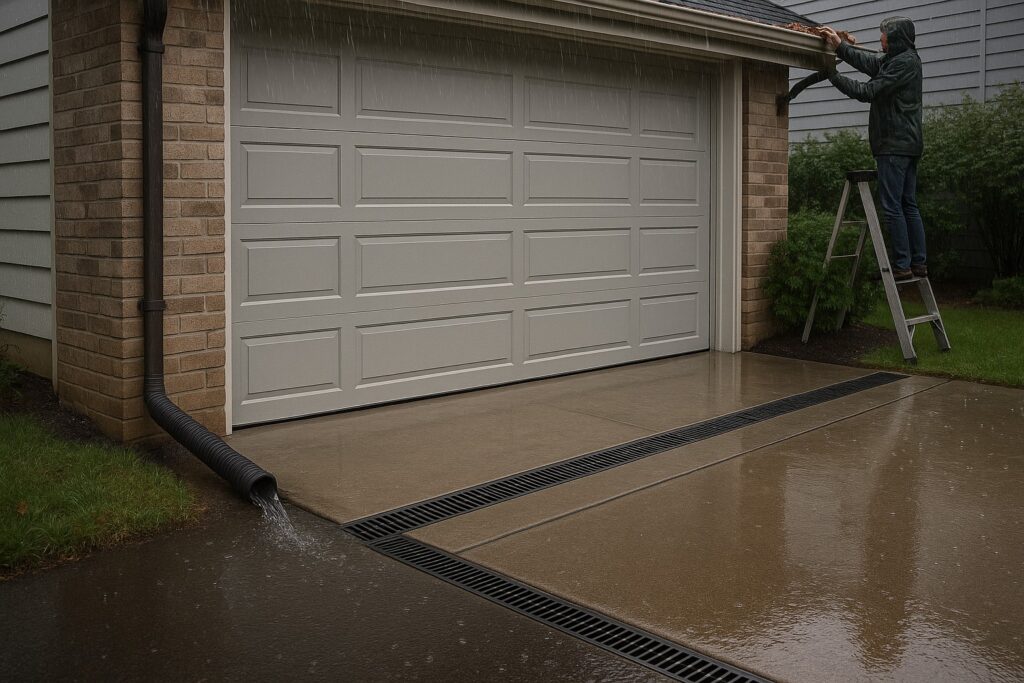
Water Damage and the Garage Door: A Real Scenario from Sugar Land
In a quiet neighborhood near First Colony, a homeowner contacted Colony Garage Doors after a recent thunderstorm led to standing water around their garage. The door would not close properly, and when our technicians inspected the area, we found signs of rot in the lower wooden panels, rust on the rollers, and mold growth on the interior insulation. This is a classic example of garage door water damage that escalates when early warning signs are overlooked. The homeowner, unaware of the importance of weather stripping and regular garage door maintenance, had allowed small leaks to worsen over several months.
According to the National Association of Home Builders, garage doors are one of the most frequently used entryways, opening and closing approximately three to five times daily in the average American household. That level of use means even small issues like weather stripping failure or worn bottom seals can lead to substantial damage over time if not addressed properly. Homeowners who learn how to repair garage door water damage early can avoid costly repairs and prolong the life of their garage door system. The average cost of minor garage door repairs is significantly less than full door replacement, and early intervention can save hundreds or even thousands of dollars.
At Colony Garage Doors, we bring years of experience and industry-leading expertise to homes throughout Sugar Land and the surrounding areas. Our step-by-step guide provides everything local homeowners need to understand the causes, symptoms, repair techniques, and preventative maintenance tips related to water damage in garage doors. Whether you’re dealing with minor moisture buildup or full-panel replacement, this comprehensive guide can help you take action confidently and protect one of your home’s most valuable entry points.
Understanding the Impact of Water on Garage Door Systems
Why Water Damage Happens in Garage Doors
Water damage is one of the most common garage door issues we encounter in Sugar Land. Heavy rain, poor drainage systems, malfunctioning gutters, and improperly sealed garage floors often allow water to seep into garage doors. In regions with high humidity and rainfall patterns like Texas and California, these problems are intensified. Homes built in low-lying areas or near retention ponds are particularly susceptible to moisture intrusion.
Water infiltrates through the bottom seal, side weather stripping, or cracks in the concrete slab. When moisture accumulates within wooden panels, metal components, or insulation layers, it begins to break down the material. Wood may warp, swell, or decay, while metal parts like hinges, springs, and tracks can corrode and weaken. Over time, this leads to wood rot, rusted springs, mold, and broken seals. Ignoring such problems increases the chance of a complete garage door replacement being needed, and more importantly, it poses a safety risk to occupants and property.
Proper grading around the perimeter of your garage, functional downspouts, and annual inspections can significantly reduce the risk of water damage. Homeowners should consider a proactive maintenance strategy to extend the life of their garage door system and avoid costly repairs.
Signs of Water Damage in Garage Doors
Several warning signs indicate that water may be compromising your garage door. Recognizing these symptoms early can help you avoid larger problems and ensure smooth operation. Here are the most common signs to watch for:
- Warped or swollen wooden panels, which may appear bubbled or soft to the touch
- Rusted or squeaky rollers, hinges, and garage door tracks often result in jerky or uneven movement
- Water stains, mold growth, or mildew odors near the garage door frame or on nearby walls and insulation
- Damp insulation or drywall near the door which can compromise indoor air quality and energy efficiency
- Uneven or noisy garage door operation, often due to corroded parts or warped panels, disrupting the system
- A door that struggles to open or close completely, indicating that water has affected the track alignment or balance

If you notice any of these issues, it is important to address them right away before the damage spreads to other garage door components such as cables, torsion springs, or safety sensors. A proactive approach helps protect the integrity of your home and improves overall garage door performance.
Step-by-Step Guide to Repair Garage Door Water Damage
Step 1: Perform a Thorough Inspection
Start with a detailed inspection of your entire garage door system. Use a flashlight to check the bottom seal, garage door tracks, panels, and corners of your garage. Pay close attention to soft or discolored wood, rust spots on metal parts, and any pooling water near the garage threshold.
Check the garage door opener, springs, and cables for signs of corrosion or moisture intrusion. Observe the garage floor for water stains or puddles. If you have insulation or drywall near the door, press gently to detect dampness or mold. Document the affected areas using your smartphone or camera. Take note of specific garage door parts that show signs of moisture damage. This information will help you decide whether a do-it-yourself repair is enough or if you need a professional garage door service.
Step 2: Dry Out the Affected Areas Completely
Before attempting any repairs, ensure the entire door and surrounding area are completely dry. This is essential to prevent mold growth and ensure repair materials adhere properly. Start by opening the garage door to increase ventilation and allow natural sunlight to help with drying.
Use fans to circulate air, a dehumidifier to reduce moisture, and towels or a wet-dry vacuum to remove standing water. For heavily soaked insulation or wallboards, you may need to remove and replace the affected sections. Consider using moisture meters to check hidden dampness behind walls or under flooring. This ensures that your repairs are built on a clean, dry foundation.
Step 3: Address Damaged Garage Door Panels
If your garage door has wood panels that have absorbed water, inspect them for rot or warping. Minor swelling can be resolved by sanding and sealing with a waterproof wood sealant or primer. This adds an extra layer of protection against future water exposure. Severe wood rot may require full panel replacement, which should be done using pressure-treated or rot-resistant lumber.
For metal garage doors, rusted spots can be treated with a wire brush followed by a rust-inhibiting primer and a durable topcoat of weather-resistant paint. Composite or vinyl panels may need replacement if they have cracked, swollen, or absorbed moisture beyond repair. Always match the replacement panels to the existing style and color for a cohesive look. Investing in water-resistant materials during replacement helps safeguard the garage from future water damage.
Step 4: Replace the Bottom Seal
The bottom seal is one of the most critical components for keeping out water and debris. Over time, rubber seals become brittle and cracked, allowing water to enter your garage. To replace the seal, begin by raising the door and removing the old strip using a flathead screwdriver or pliers.
Clean the garage door track thoroughly and install a new bottom seal designed to fit your specific garage door model. Choose a heavy-duty rubber or vinyl seal for long-lasting performance. Threshold seals, which adhere to the garage floor, can provide additional protection from pooling water and ensure a tight seal. When correctly installed, a bottom seal can also help with pest prevention, dust control, and energy efficiency.
Step 5: Clean and Lubricate All Moving Components
Rust on garage door springs, rollers, hinges, or tracks not only impairs performance but can also become a safety hazard. Clean rust using steel wool or sandpaper and treat the area with a rust inhibitor. Once clean, apply a high-quality garage door lubricant to all moving parts to prevent friction and future corrosion.
Never use grease, which attracts dust and debris. Instead, choose a silicone-based spray or lithium-based lubricant approved for garage door components. Make this part of your seasonal garage door maintenance routine. Well-lubricated components ensure quieter operation, longer lifespan, and improved safety.
Step 6: Re-Seal and Insulate for Long-Term Protection
Re-seal around the perimeter of the garage door by replacing worn weather stripping and side seals. Make sure to press the new stripping firmly into place and secure it with galvanized screws or nails. Gaps or improper sealing can lead to recurring moisture issues.
Install insulation with a high R-value to improve energy efficiency and reduce moisture retention in the garage. Use foam board, reflective foil, or fiberglass batting, depending on your climate and door type. Homeowners in Sugar Land often overlook garage door insulation, but it plays a critical role in regulating temperature and protecting against condensation, especially during warm, humid months. Upgraded insulation also reduces energy bills and supports overall home comfort.
Proactive Maintenance and Prevention Tips
Install Proper Drainage Systems
Ensure rainwater flows away from your garage by grading your driveway, extending gutter downspouts, and installing a trench or French drains. If water tends to collect near your garage entrance, these systems help direct it safely away, preventing future damage. Regularly clean your gutters and inspect for clogs or leaks, especially during storm season.

Invest in concrete resurfacing or leveling if your garage floor has settled or formed low spots where water can pool. Proper drainage is one of the best long-term defenses against garage door water damage.
Conduct Seasonal Tune-Up Services
Schedule seasonal garage door maintenance twice a year, ideally before the rainy season and after summer. Professional tune-up services include inspections of garage door springs, cables, sensors, and garage door openers to ensure everything functions safely and efficiently.
Regular maintenance prevents small issues from turning into major garage door problems. It also extends the lifespan of your garage door and improves its performance. A tune-up service may include spring tension adjustments, track alignment, and replacement of worn rollers, providing complete peace of mind.
Upgrade to a Water-Resistant Garage Door
If your current garage door is outdated or frequently affected by moisture, it may be time to install a new garage door made from water-resistant materials. Modern steel or composite doors offer enhanced durability, lower maintenance, and better insulation.
New garage doors designed for regions like Sugar Land or California feature advanced sealing systems, corrosion-resistant hardware, and energy-efficient construction. These upgrades provide long-term protection and better curb appeal. Many models also come with extended warranties and improved safety features, including high-tech sensors and quiet-operation garage door openers.
Check and Replace Safety Sensors
Water damage near the floor of your garage can also impact safety sensors and garage door openers. Sensors that are out of alignment or exposed to water may cause the door to stop unexpectedly or fail to close.
Test your safety sensors regularly to ensure they detect obstacles and function properly. Replace them if they are corroded, misaligned, or affected by moisture. Modern sensors include LED indicators that make troubleshooting easier for homeowners.
When to Call a Local Garage Door Professional
While minor garage door repairs can be done using basic tools and some do-it-yourself knowledge, more complex water damage issues should be handled by professionals. Call a local garage door company if you experience:
- Structural damage to the garage door panels or frame
- Severely rusted or broken garage door springs
- Faulty garage door openers due to water exposure
- Door misalignment, sagging, or heavy resistance during operation
Emergency garage door services are available for urgent repairs. Do not attempt to adjust high-tension components such as torsion springs or cables without proper training, as these can pose serious safety risks. A professional garage door technician has the expertise, tools, and replacement parts needed to ensure safe, lasting repairs.
How Can Colony Garage Doors Help You?
At Colony Garage Doors, we are committed to providing Sugar Land, TX, homeowners with expert advice, reliable repairs, and top-notch customer service. Our team is trained in cutting-edge techniques to handle everything from broken springs and malfunctioning garage door openers to severe water damage and garage door replacements.
We proudly serve residential and commercial clients throughout Sugar Land and nearby communities. Whether you need seasonal garage door maintenance, urgent garage door repair, or an entirely new garage door installation, our team is ready to deliver efficient, affordable, and long-lasting solutions.
We offer flexible appointment times, transparent pricing, and fast emergency garage door repair services. As your local garage door experts, we are committed to keeping your home protected, your system running smoothly, and your family safe year-round.
Call us today at (832) 345-9267 or visit us at Southwest Fwy Unit A, Sugar Land, TX 77479 to schedule a free quote or emergency garage door service.
Final Thoughts
Water damage can be one of the most frustrating and costly problems affecting your garage door. However, with early detection, a solid repair plan, and ongoing maintenance, you can protect your home from extensive repairs and preserve the safety, performance, and appearance of your garage door system.
Remember, the garage door is not just an entry point; it is a key component of your home’s safety and energy efficiency. Keeping it in top condition ensures your family stays safe, your belongings stay dry, and your daily routines remain uninterrupted.
If you are facing garage door problems related to water damage, rust, or wear and tear, trust the experts at Colony Garage Doors. We are your undisputed industry leader in Sugar Land, bringing top-tier team experience, precision garage door services, and dependable workmanship to every job. Reach out today and discover how easy it is to restore the integrity of your garage door system and enjoy long-term peace of mind.
Frequently Asked Questions (FAQs)
1. Can garage door water damage affect my garage door opener?
Yes, prolonged exposure to moisture can damage the internal electronics of your garage door opener, especially if the opener is mounted low or near areas prone to leaks. This can lead to erratic door behavior or total failure of the opener system.
2. How long does it take to repair water damage in a garage door?
The time needed depends on the extent of the damage. Minor repairs like sealing or hardware replacement can take a couple of hours, while severe panel or opener replacements may require a full day or professional scheduling.
3. Are water-resistant garage doors more expensive than standard doors?
Yes, water-resistant garage doors typically cost more upfront due to materials like galvanized steel, fiberglass, or composite panels. However, they offer long-term savings by reducing maintenance and preventing costly repairs.
4. Can I use a waterproof paint to prevent water damage on my existing garage door?
Waterproof paint can help add an extra layer of protection, especially on wood or metal doors, but it should be part of a larger prevention plan. Proper sealing, drainage, and routine maintenance are still essential for complete water damage prevention.
- Which Garage Door Types Are Most Energy-Efficient in Sugar Land, TX Homes and Businesses?
- The Importance of Scheduling Timely Commercial Garage Door Repair in Sugar Land, TX
- How to Repair Garage Door Water Damage in Sugar Land Homes
- How Weather Stripping Prevents Water Damage in Sugar Land Garages
- Why Sugar Land, TX Residents Are Prioritizing Garage Door Repairs This Season
